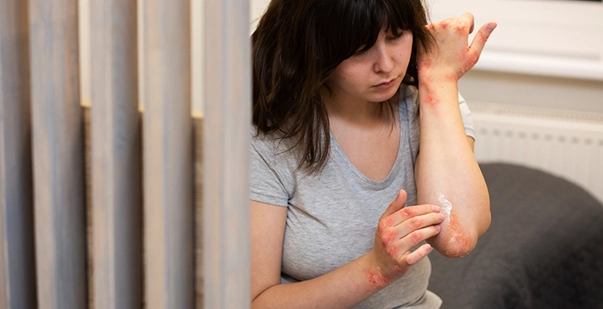In the United States, burns are a prevalent form of injury, with approximately 486,000 individuals seeking medical treatment for burn injuries annually. These injuries vary in severity, ranging from minor first-degree burns to severe third-degree burns requiring immediate medical attention. While most burns occur at home, workplace-related burns are also common. Prompt and proper burn treatment is essential to minimize complications and promote healing. Read on to learn how to treat a burn and its various types.
What are the different types of burns?
You may not feel it, but all burns are not the same. As mentioned below, medical science classifies burns based on different types and sources.
- First-degree burns only affect the skin’s outer layer, causing redness and pain.
- Second-degree burns affect the first two or three layers of skin, causing blistering, pain, and swelling.
- Third-degree burns destroy the outer layer and underlying skin layers, often resulting in white or blackened skin, numbness, and severe pain.
- Fourth-degree burns are for layers of the skin, potentially damaging muscle, bones, and internal organs, leading to charred skin, loss of sensation, and life-threatening complications.
- Electrical burns are caused by electrical currents passing through the body, resulting in entry and exit wounds and internal damage.
- Chemical burns: Contact with corrosive substances causes these burns. They lead to tissue damage, pain, and potential systemic effects.
Read More: First aid course in Seattle
How do we identify the types of burns?
The causes of different types of burns vary depending on the nature and severity of the injury. You can only know how to heal a burn well when you know its cause. Here are the common causes associated with each type of burn:
- First-degree burns:
- Sunburn: Prolonged exposure to ultraviolet (UV) radiation from the sun.
- Minor thermal burns: Contact with hot objects, steam, or liquids.
- Second-degree burns:
- Scalds: Contact with hot liquids, such as boiling water or hot oil.
- Thermal burns: Contact with flames, hot surfaces, or heated objects.
- Chemical burns: Exposure to corrosive chemicals, including acids, alkalis, and solvents.
- Electrical burns: Contact with electrical currents or sources of electricity.
- Third-degree burns:
- Thermal burns: Prolonged exposure to flames, extreme heat, or scalding liquids.
- Chemical burns: Exposure to strong acids, alkalis, or other corrosive substances.
- Electrical burns: Contact with high-voltage electrical currents or sources of electricity.
- Radiation burns: Exposure to ionizing radiation from X-rays or radioactive materials.
- Fourth-degree burns:
- Similar causes as third-degree burns but with more severe and extensive tissue damage, often involving prolonged exposure to extreme heat, electricity, or chemicals.
- Electrical burns:
- Contact with live electrical wires, outlets, or appliances.
- Lightning strikes.
- Accidental contact with high-voltage electrical equipment or power lines.
- Chemical burns:
- Direct contact with corrosive substances causes these burns.
- Inhalation or ingestion of toxic chemicals or fumes.
Read More: Self Paced first aid Classes Near Me
How to Treat a Burn?
Treating different types of burns requires specific interventions based on the severity and extent of the injury. Here are general guidelines first aid for burns:
- First-degree burns:
- Cool the burn: Apply a cool, moist compress.
- Pain relief: Over-the-counter pain medications can also help
- Second-degree burns:
- Pain relief: Over-the-counter pain medications like ibuprofen or acetaminophen can help manage pain and inflammation.
- Do not break blisters: Leave blisters intact to protect the underlying skin and prevent infection.
- Dress the burn: Apply a sterile, non-adhesive bandage to protect the burn and keep it clean.
- Third-degree burns:
- Seek medical attention immediately: Third-degree burns require instant treatment to prevent complications and promote healing.
- Do not apply ice or water: Avoid cooling the burn, which can worsen tissue damage.
- Cover the burn: Use a clean, dry cloth or sterile dressing to cover the burn and protect it from infection.
- Monitor for shock: Third-degree burns can cause shock, so monitor the person’s vital signs and seek emergency medical care if necessary.
- Fourth-degree burns:
- Medical emergency: Fourth-degree burns require immediate medical attention in a hospital setting.
- Do not attempt home treatment: These burns are severe and often life-threatening, requiring specialized medical care.
- Electrical burns:
- Turn off the power source: If it is safe, turn it off before approaching the person with an electrical burn.
- Check for other injuries: Electrical burns can cause internal injuries, so assess the person for other signs of trauma.
- Seek medical attention: A healthcare professional must evaluate Even minor electrical burns to assess for more profound tissue damage.
- Chemical burns:
- Remove the chemical: Rinse the affected area with water for at least 20 minutes to remove the chemical and prevent further tissue damage.
- Remove contaminated clothing: Remove any clothing or jewelry that may be contaminated with the chemical.
- Seek medical attention: Chemical burns can be severe and require professional medical treatment to prevent complications and promote healing.
Conclusion
Burn treatment is a crucial skill that can help you save lives. Timely intervention through first aid, after a person experiences a burn could prevent lifelong damage and help with a faster recovery. Everyone must know the basics of burn management and keep their loved ones safe.













